9 essential tips for using stompboxes in your studio
Get epic and nasty with your pedals
Hopefully, you'll agree that using stompboxes in your studio is a good idea, and if you do, we have some essential tips on how to make them work for you.
1. Watch your levels
Many pedals designed for guitar cannot handle the hotter output of synths that well. Listen for distortion and dial back your synth volume if you need to.
2. Make synths thicker or wider
Although many hardware synths offer dynamic panning, layering and effects these days, this type of functionality dominates mainly in the digital arena. Adding a stereo chorus is a great way to make a synth both thicker and stereophonic, particularly those that might be underpowered in other ways. This is a ploy that Roland, and many others, employed in the '80s to beef up keyboards like the Juno-106 (which lacked individually detunable oscillators). Given the prices of some mono chorus pedals you could even try using two together (one for the left and one on the right).
Slowly modulating flanging is another effect that works well on pads and pulsing sequenced synth parts.
3. True bypass
A quick search on the internet for 'tone suck' shows that some stompboxes (slightly) alter the tone of anything passing through even when bypass is engaged. If you have a pedal that's going to be patched more permanently, then look for one with a 'true bypass' switch.
4. Reverbs, springs and things
Reverb may seem like it's best left to plugin or rack processors. However, there is a place for recording with it already applied, especially when using longer and more extreme reverb settings.
The Strymon blueSky has various reverb types covering plates, rooms and springs, but it also offers mod and shimmer variations. Subtle pitch modulation applied to a reverb works brilliantly on big reverbs for '80s synth stabs, but the shimmer option is very special. By adding regenerative upwards pitchshifting, a cloud of higher harmonics is created to sit on top of the original.
Although not strictly a stomp box - though spring reverb pedals are available - a lot of fun can be had (for about £30) by running the aux send from your desk into a headphone amp and on to a guitar reverb spring tank. Patch the spring's output into a spare channel's mic input for instant dull, twangy and resonant reverb.
Get the MusicRadar Newsletter
Want all the hottest music and gear news, reviews, deals, features and more, direct to your inbox? Sign up here.
5. Don't forget your beats
Pedals can be applied to more than a guitar or synth. Drums are a prime candidate for being mashed or tweaked. Try running all your drums through a distortion or delay.
© Uli Deck/Corbis
6. Be epic
Effects are an important factor in achieving epic synth soundscapes. TC Electronic Hall of Fame reverb pedal is surprisingly effective at adding long modulated reverb to synths with simple hands-on control (and more complex editing via USB if required) - there's also a cheaper single-knob mini version. Or dial in a shimmer effect. This combination of delay, pitchshifting and reverb finessed by Brian Eno (above) and Daniel Lanois creates a halo of reverberant high harmonics on top of anything you play. Strymon have this as a dedicated mode in their blueSky reverb pedal and its bigger brother the Strymon BigSky.
© Rune Hellestad/Corbis
7.Get that Jean Michel Jarre Oxygène pad
Synth music was promoted hugely by Jean Michel Jarre's first two albums, Oxygène and Équinoxe. Both make heavy use of the string ensemble section of an Eminent 310 organ run into an Electro-Harmonix Small Stone Phaser to provide the, now-clichéd, sweeping synth pads. He wasn't the only one doing this - the string-machine plus phaser combo can be heard in many other places, including Donna Summer's I Feel Love produced by Georgio Moroder, who counts Daft Punk among his fan-boy friends. Slowly modulating flanging is another effect that works well on pads and pulsing sequenced synth parts.
8. No two pedals are the same
Different models of phaser and chorus, for example, will effect the sound in different ways. Try comparing, say, the MXR Phase 90 to an Electro-Harmonix Small Stone.

9. Create metallic nastiness
The beauty of guitar pedals is the ease with which they can be patched together to create your own individual sonic mayhem. Instant inharmonic craziness can be achieved almost instantly with an effect like the Way Huge Electronics Ringworm. This is a ring-modulator with blend control and LFO. A ring-modulator creates sum and difference signals between twin inputs. In this case, one input is that from your guitar, synth or drum machine, and the other is an internal oscillator. The LFO (or external CV) can be used to modulate the pitch of the internal oscillator and a blend control is used to balance this with the source.
For more information on how to get more out of stompboxes in electronic music check out Future Music 293, which is on sale now.
Future Music is the number one magazine for today's producers. Packed with technique and technology we'll help you make great new music. All-access artist interviews, in-depth gear reviews, essential production tutorials and much more. Every marvellous monthly edition features reliable reviews of the latest and greatest hardware and software technology and techniques, unparalleled advice, in-depth interviews, sensational free samples and so much more to improve the experience and outcome of your music-making.
“The included sample content is not only unique but sonically amazing, as it always was”: Spitfire Audio BBC Radiophonic Workshop review
“We were able to fire up a bass sound that was indistinguishable from the flavour of New Order’s Blue Monday in seconds”: EastWest Sounds Iconic review










